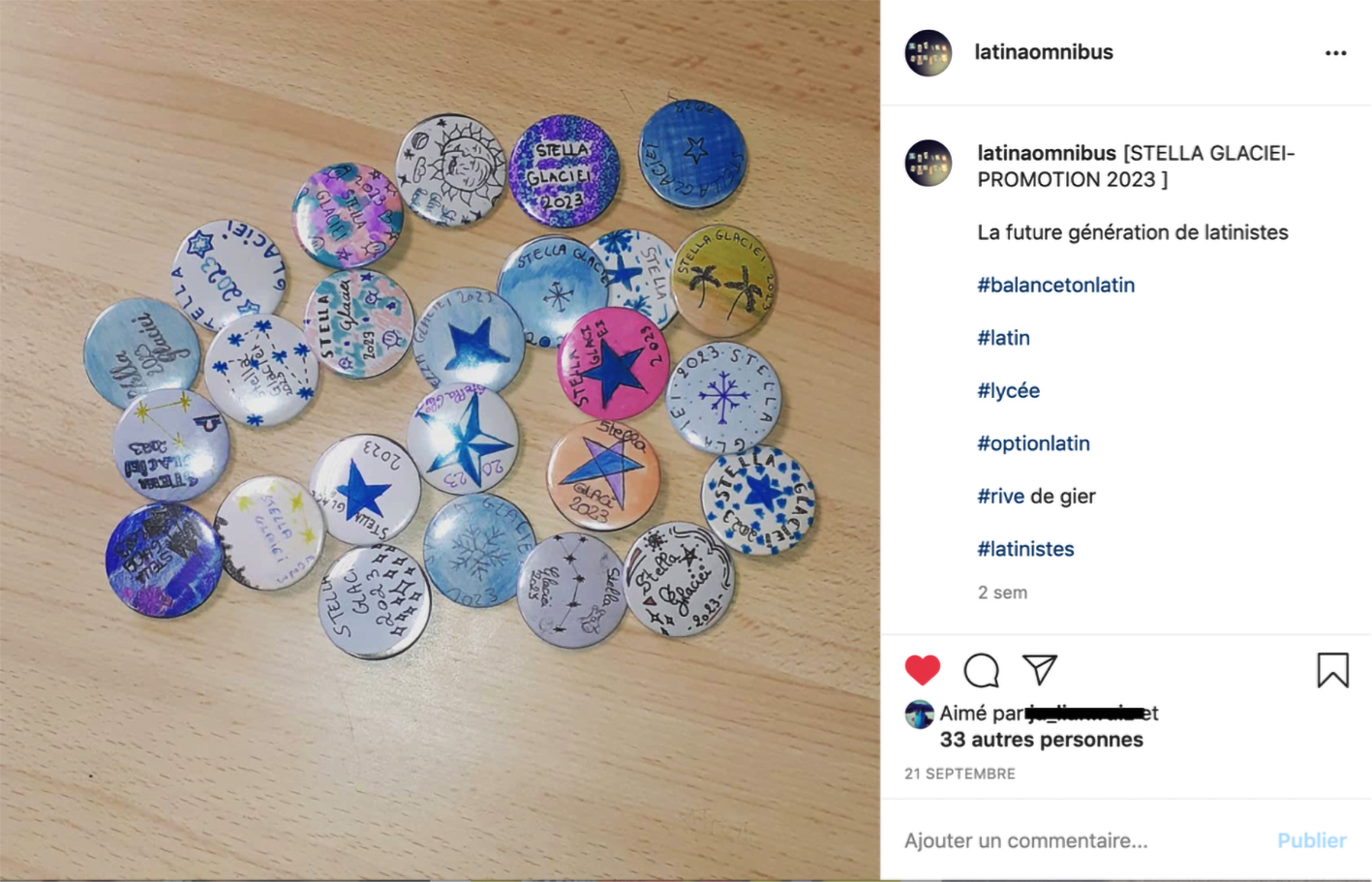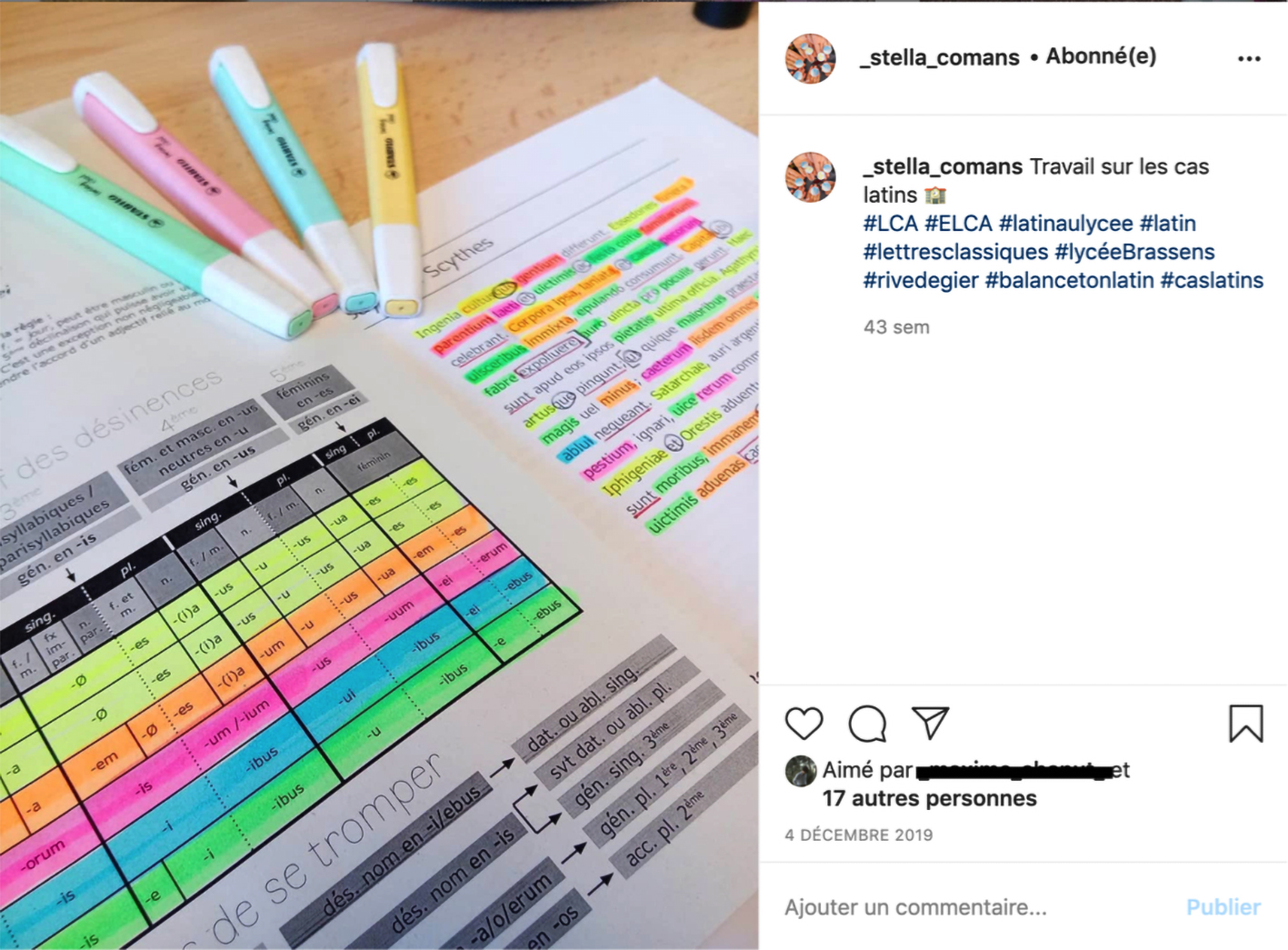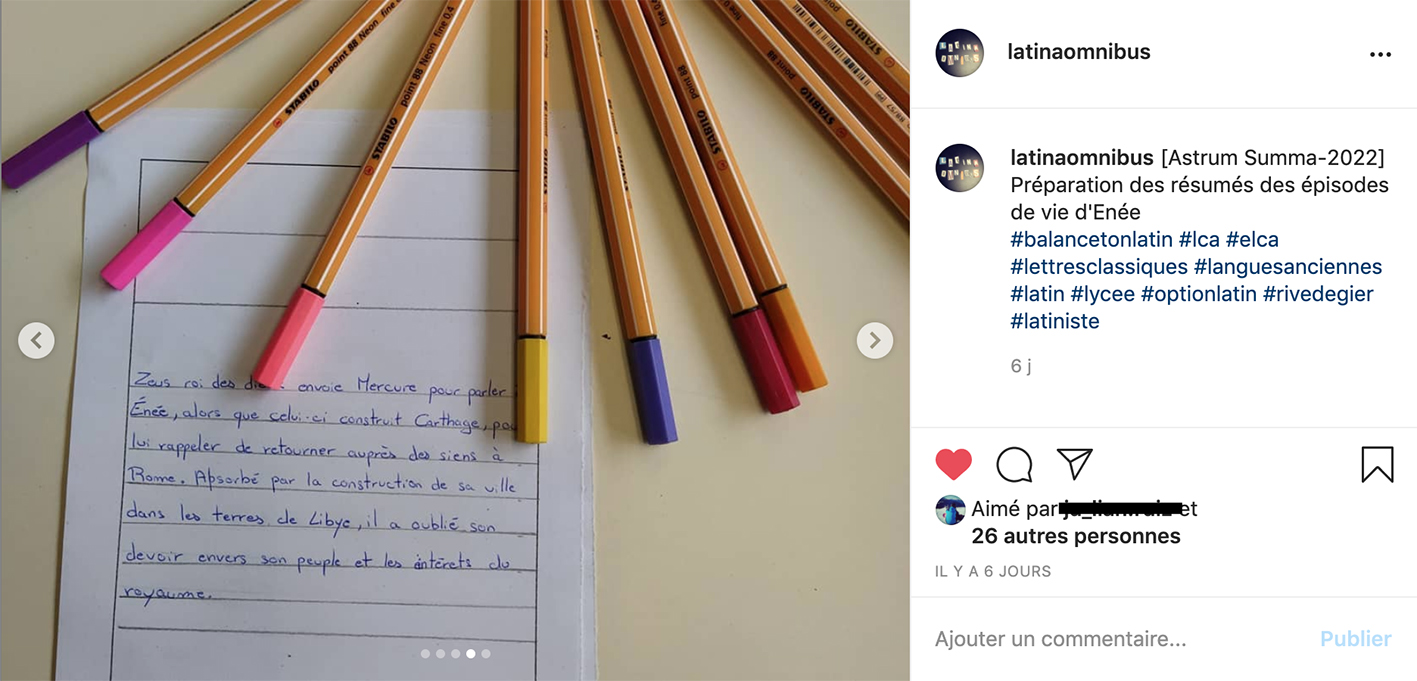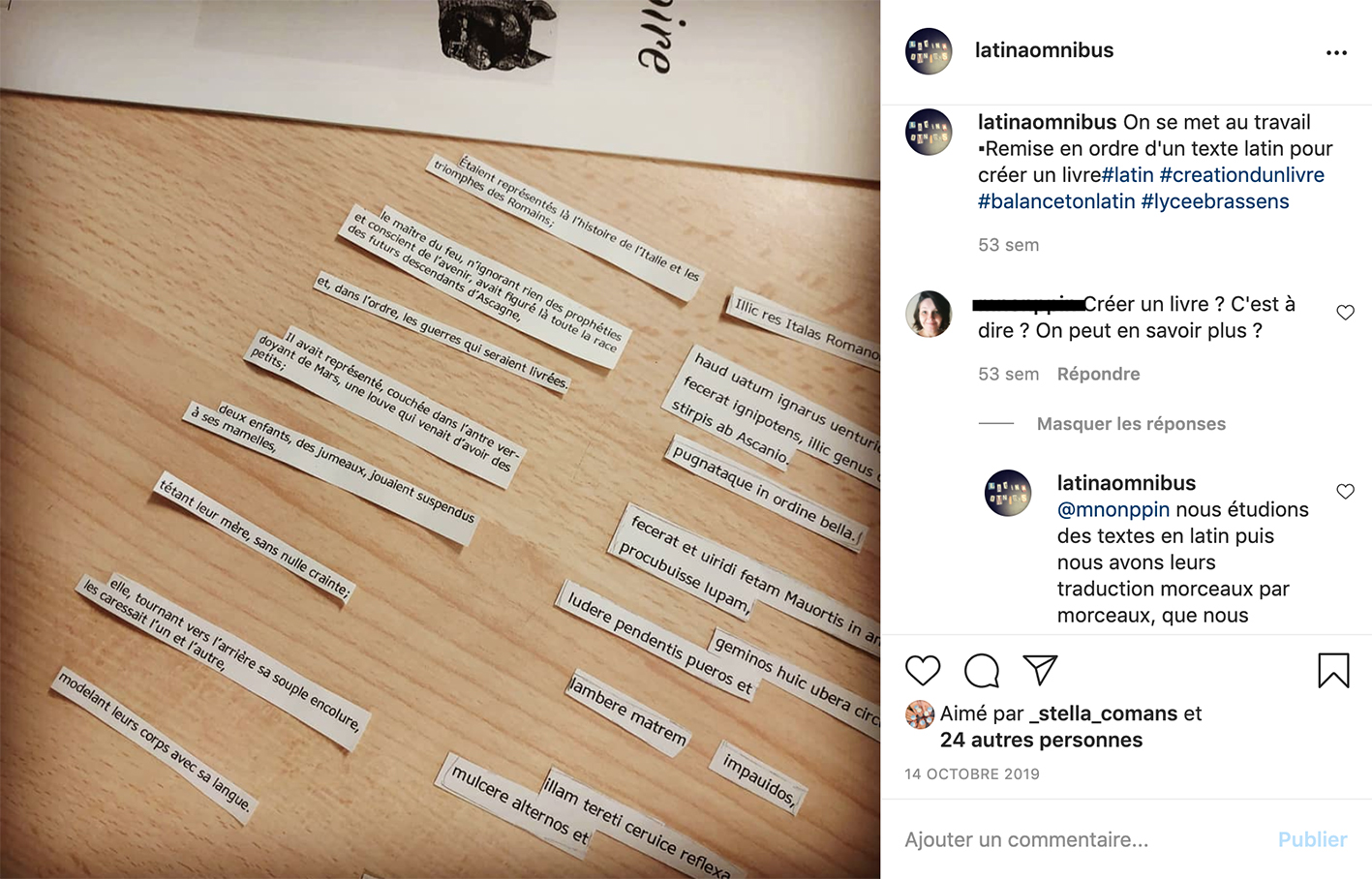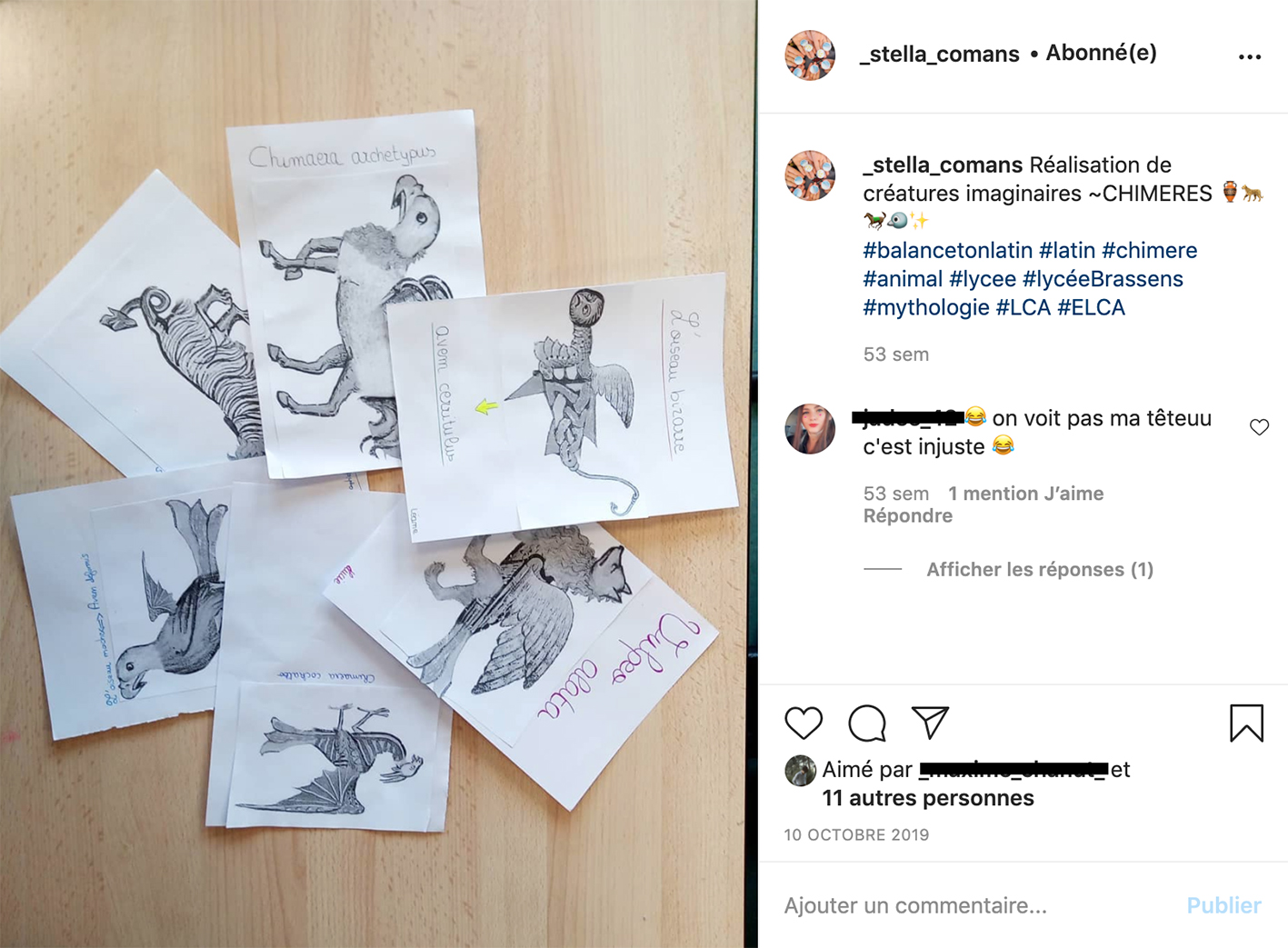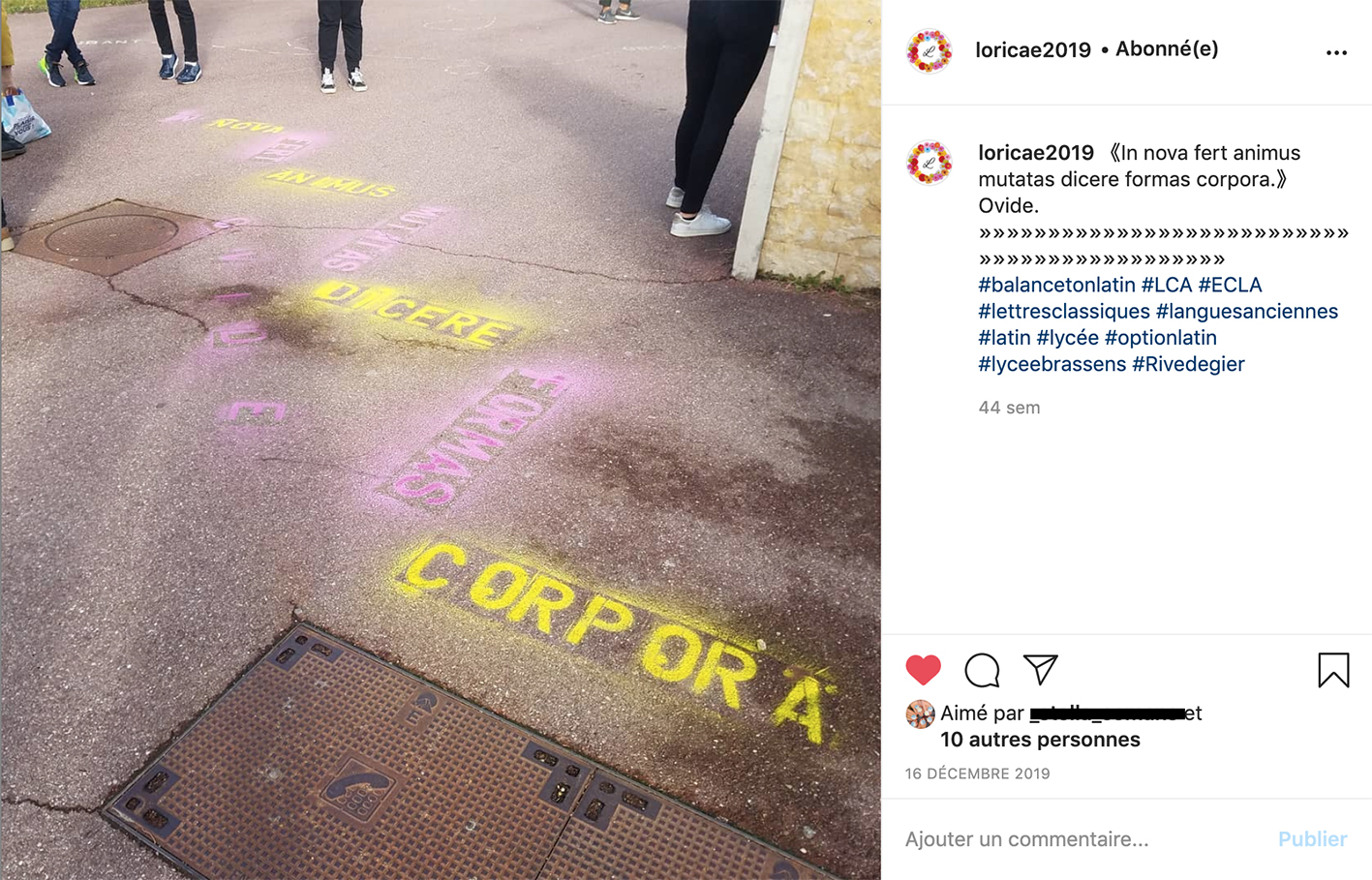1. Introduction
1.1. The situation of classical languages in France
According to a French government report regarding the promotion of languages and cultures of antiquity, in 2017, only 4.9% of high school students chose to take a Latin course. The authors of the report also highlight that the number of Latinists has been declining over the past two decades: "Depuis vingt ans, les effectifs d'élèves suivant un enseignement de langues et cultures de l'Antiquité baissent de manière régulière, au collège et au lycée" (Charvet & Bauduin, 2018, p. 39)1.
Pascal Charvet and David Bauduin, the authors of the report, point out that among the many reasons for this decrease, there is a misconception regarding the discipline: "une conception stéréotypée de la discipline: malgré un renouvellement considérable de l'approche et des démarches, la discipline pâtit encore aujourd'hui auprès du grand public d'une image fausse, souvenir de pratiques de classe depuis longtemps révolues" (p. 40)2.
For this reason, one can easily understand the necessity for all classical letters teachers to ponder the question of how to restore the appeal of a discipline that is regarded as outdated. It is necessary for those of us who teach this discipline to contemplate ways in which we can illustrate the constant modernity of classical languages.
1.2. An experiment
This leads to one of the questions that initiated the experiment that I have chosen to conduct since the start of the 2018 school year, namely, how does one enable students to find meaning in a Latin class? Indeed, three years ago, when I first arrived at the 'Lycée'3 Georges Brassens (in the city of Rive-de-Gier, near Lyon), there was only one group of Latinists, consisting of five, in 'terminale'4, and the option had already disappeared in 'seconde'5 and 'première'6.
The experiment conducted at the 'Lycée' Georges Brassens involves project-based learning, that, according to doctor of educational sciences Michel Huber, enables a response to several problems encountered in the education system in general and encountered by us in our Latin classes. Students have difficulty in finding meaning in school attendance; the school fails to foster the learning of citizenship among students, and it does not succeed in creating links between the place of learning and life. However, one could ask how project pedagogy would overcome these challenges. In his book Apprendre en Projets: la Pédagogie du Projet-élèves, Huber (2005) defines project pedagogy as
est un mode de finalisation de l'acte d'apprentissage. L'élève se mobilise et trouve du sens à ses apprentissages dans une production à portée sociale qui le valorise. Les problèmes rencontrés au cours de cette réalisation vont favoriser la production et la mobilisation de compétences nouvelles, qui deviendront des savoirs d'action après formalisation. (p. 18)7
The experiment that I propose to present involves moving Latin out of the classroom through tagging Latin quotes in the school yard, which will be central to the entire project. Therefore, this implies organising a mediation path for non-Latinists and developing mediation materials based on the class activities.
This experiment has multiple goals.
First, to turn the students into independent translators of Latin texts by setting up an appropriate favourable framework and lending support, and,
second, to create cohesion among the students and encourage them to take ownership of the project, while the Latin as a language and a culture is popularised through taking it out of the classroom via tags in the school space and digital dissemination of the project.
However, it is important to know how project-based learning can guide students to independent learning of Latin and stimulate renewed interest in this discipline. The experiment alternated different methods of working, namely, collective, collaborative, cooperative, and individual. This means that the students are guided by the activities proposed by the teacher and confronted with the challenge of having to work independently, alone or in collaboration with others.
Next, I present the project and the organisation that provided a framework for the project. Thereafter, the course is described in a sequence, after which some results of this experiment are reported.
2. Presentation of the project "Take Latin out of the Classroom"
Building on the work undertaken by Freinet (1973) in particular, the collective project included the publication of a book, a poster, tags within the school and dissemination through Instagram posts.
2.1. A circuit of mediation in high school
By being guided to take Latin out of the classroom, the students provide and build a circuit of mediation non-Latinists, whether school staff or students. This circuit begins with the reading of Latin quotes inscribed with chalk bombs in the school yard.
The professor selected original quotes from Latin authors, according to several criteria. First, the quotes are chosen according to their relevance to the developed sequence. For example, the quote from Ovid's Metamorphoses "in noua fert animus mutatas dicere formas/Corpora (1, 1-2)" fits into a sequence that questions the metamorphosis of bodies in "seconde"; the "terminale" students, will, for example, tag a quotation from letter 1 of Seneca's "omnes horas complectere (1, 1)" in relation to a sequence of the answers provided by the Stoic and Epicurean philosophers to questions relating to time and death. In addition, the choice of a quote is dictated by its simplicity and ability to be memorized; regularly repeating the inscription on the ground enhances the students' retention of it. Finally, the length of the citation is a criterion to consider since the time to stencil it can be significant.
The circuit continues in the corridors of the high school through the reading of the posters that replicate the text from the quotation and provide a translation into French. Finally, it ends in the high school library, where the book produced by the students is located with a selection of books from the collection in the library, as well as an exhibition that presents the activities conducted in class, such as a map of the Mediterranean or a timeline.
The book that the students produce is the starting point of learning for Latinists and the first condition for establishing mediation with non-Latinists. Learners develop translation skills, and non-learners, high school students or staff, extend their knowledge and reflection through reading the quote and its translation on the poster.
The dissemination of the project on the Instagram social network has a dual purpose. First, it is an opportunity for the students to keep a logbook and document their actions. Furthermore, it has the effect of widening the circle of learners through reaching a wider audience than only the high school and even promoting the teaching of Latin to future Latinists.
It is necessary to establish a clear and rigorous framework to conduct this project, as the students have to adopt it, and also because they should become as independent as possible, both in terms of a text and the proposed activities. This is why it is essential to create the conditions that will allow the development of cohesion and a common working method among the class group from the beginning of the year.
2.2. The start of the year: a crucial period to establish a solid foundation for the group project
2.2.1. Create the conditions for group cohesion
To create cohesion within the group, students are invited to choose a name for the class at the start of the year. Each student or group of students propose terms that they translate into Latin before submitting them to the others. A vote is then taken, and the class has a name that will be retained for the three years of high school (Figure 1). The name will be used during the project.
Thus, early this year, 'seconde' students, for example, chose to be called "Stella Glaciei" and 'terminale' students, "latina graphice"; although awkward, this name refers to the many graphic activities conducted in their Latin curriculum over the past two years. This choice initiated a debate showing their desire to find a name that makes sense for everyone and can be appropriated by all.
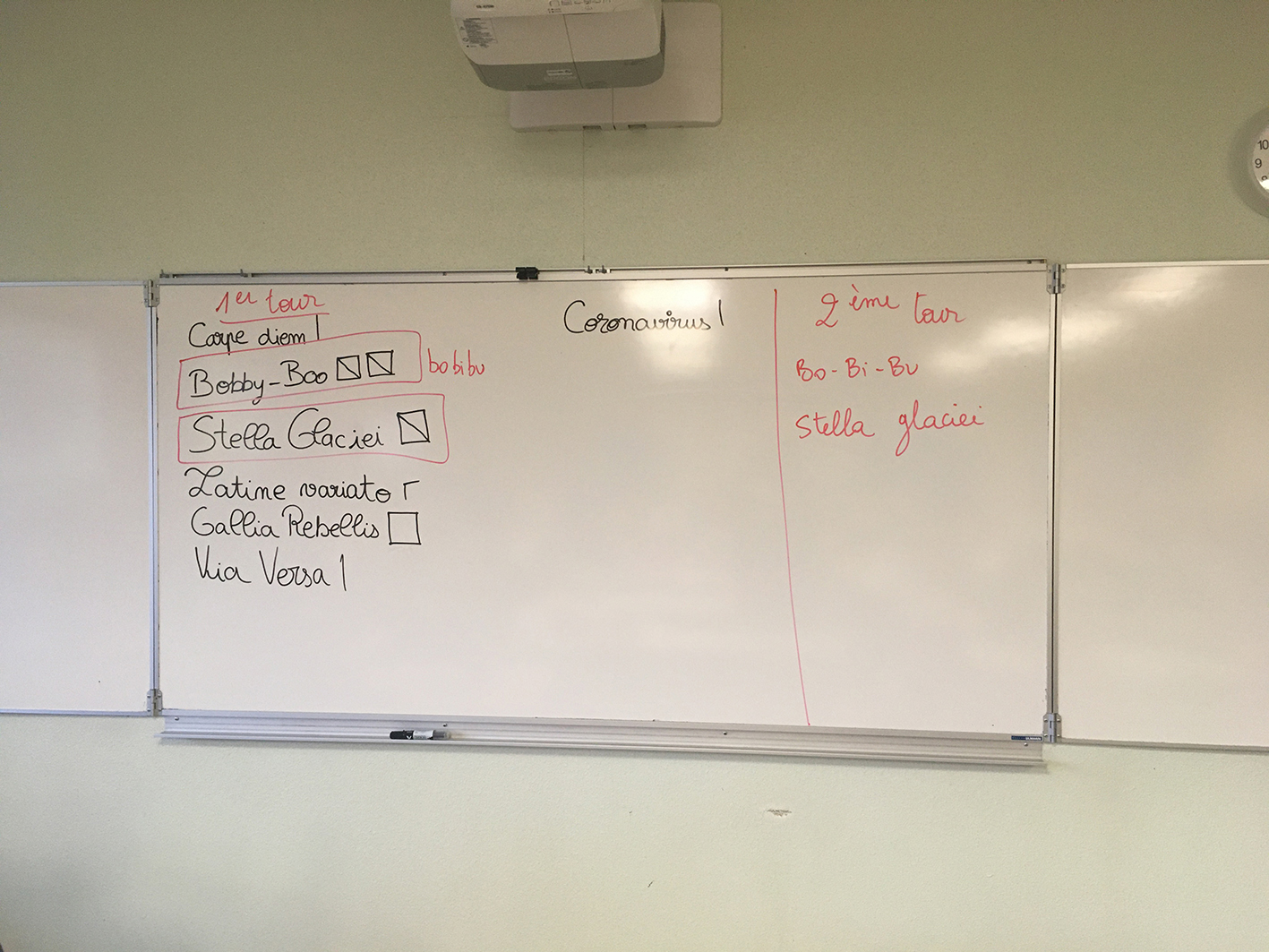
Figure 1. Picture of the classroom whiteboard used by the 'seconde' students to record the proposals and votes (1st and 2nd round)
Once the name had been chosen, students were invited to each create a badge that contains the name of their class (Figure 2). This activity should increase a feeling of belonging to this newly created group. Moreover, this moment is in support of the first Instagram post of the year.
2.2.2. Create a common framework for reading and translating a Latin text
2.2.2.1. Learn to navigate in a grammar handbook
The primary objective of this experiment is to make students independent in regard to a Latin text. For this purpose, they have a grammar handbook provided by the teacher. To ensure that students understand how to use the handbook, it is necessary to go through a stage of collective ownership at the start of the year, with a text proposed to the whole class and the steps provided by the teacher followed scrupulously. When it is necessary to identify the form of a verb, the case of a noun or a preposition, the teacher indicates the appropriate pages the students should refer to.
To take stock of the discipline, Augé (2013) provided a test for Latin students and noted that "les savoirs ne sont que très rarement mis en place dans une cohérence qui en facilite la compréhension et la mémorisation"8 and that "les savoirs mal acquis paralysent et ruinent l'initiative au lieu d'aider à construire un apprentissage"9. It is on the basis of this sharing of observations that the grammar guide was developed and also the certainty that students should be able to know how to use it rather than possess knowledge that they are unable to employ. Therefore, it is important to ensure that the students know how to translate a text using a grammar handbook rather than knowing their declensions without being able to apply the knowledge to the translation of a text.
2.2.2.2. Adopt a unified method
Moreover, the first part of the year is an opportunity to instruct students on a method that they will be able to apply systematically. They begin by circling conjunctions in black, underlining conjugated verbs in red, framing infinite verbs in red and underlining adverbs in black. After these initial observations, the task is to identify cases of nouns and adjectives. To facilitate the transition from text analysis to translation and to have a unified method in the group, they are advised to use a colour scheme10. Therefore, they must identify nominatives and vocatives in yellow, accusatives in orange, genitives in pink, datives in blue and ablatives in green (Figure 3). With this method, the students can translate word group by word group, with the colour scheme that highlights the different functions of the sentence.
2.2.2.3. Students in control of their language learning
Finally, students are set free in their acquisition of grammar concepts, so that they feel in control of their learning and are able to measure their progress. In the tradition of Washburne or Freinet, who established freedom in the rhythms and personal control of learning (Freinet, 1973), learning autonomy refers to the following:
à la capacité de l'apprenant de prendre en charge son apprentissage. Est autonome un apprenant qui sait apprendre, c'est-à-dire préparer et prendre des décisions concernant son programme d'apprentissage: il sait se définir des objectifs, une méthodologie et des contenus d'apprentissage, il sait gérer son apprentissage dans le temps, et il sait évaluer ses acquis et son apprentissage. (Cuq, 2003, p. 31)11
For this purpose, students have one language-learning program per year. They have to complete five language assessments each term. They are free to choose the timing and the topic. In addition, as progress in the activities of the sequence may differ, depending on the students or their group, some may find themselves unoccupied; they then have the choice of either reading Latin books for beginners, revising notions of the language, or even to sit for their evaluation.
This practice allows students to be individually supported. In fact, it is common for students to ask for explanations on a particular point of language during revisions. Therefore, the students are not left unattended, but they are the masters of their own learning. In addition, they are allowed two attempts at the assessment. If they fail the assessment at first or feel they can do better, they can ask to retake it. Thus, the students can benefit from a remedial period between the two evaluations where the teacher will be able to explain and assist in areas where the student has shortcomings.
In addition to students' ability to navigate independently in their grammar handbook, this way of working aims to respond, to a certain extent, to a shared observation, which Augé (2013) recalled: the students have little command of morphology and syntax and have many shortcomings. As soon as they know how to use this document, they can be more confident in their relationship with Latin texts and feel more legitimate in their learning. They can also monitor their progress more easily.
2.3. Alternate individual, collective, collaborative and cooperative times
To conduct the project, the students will work either individually, in a cooperative or even collaborative manner or even collectively throughout the year and the pedagogical sequences. If it is easy to distinguish between individual work and collective work, it seems important to define the way in which cooperative learning differs from collaborative learning.
In their work entitled Apprentissage Collaboratif à Distance, Henri and Lundgren-Cayrol (2001) describe the distinction between cooperative and collaborative learning. They define cooperative work as group members participating in the development of collective work, guided by a trainer: "L'apprentissage se fait en équipe. Le travail réalisé par chaque équipe contribue à l'œuvre collective. […] La structure de l'activité pédagogique est imposée. L'exploration et la découverte du contenu sont guidées par le formateur selon une structure imposée" (p. 40)12.
However, collaborative learning refers to work done individually and shared with other learners:
L'apprentissage résulte du travail individuel soutenu par des activités de groupe ou d'équipe. L'apprenant partage des ressources avec le groupe et utilise le travail réalisé en groupe pour apprendre. […] La structure de l'activité est souple et ouverte. Les parcours d'exploration et de découvertes sont libres. (p. 40)13
Thus, alternating these learning methods can contribute towards making learners autonomous.
Moreover, each task done individually or in a group becomes the subject of an oral presentation to the remainder of the class, so that the knowledge acquired by some enriches others.
Finally, many pedagogues, including Meirieu (1984), have been able to point out or realise, like Freinet, the pitfall that can arise from the organisation of a collective project, leading to a form of marginalisation of learning. The project submitted in this article does not escape this pitfall. A collective activity often takes precedence over the learning of individual knowledge. The proposal of individual tasks that still contribute to the group project and the autonomous learning of the language are some initial solutions for this pitfall.
3. The example of a sequence entitled "myths and metamorphoses"
To present the educational organisation of the course that I developed, I used the sequence intended for 'seconde' students, entitled "myths and metamorphoses". This sequence is a work in progress, but I will lean on examples from other levels and from previous years since each sequence is organised in the same way, whatever the level.
First, a text is worked collectively, the entire class with the teacher, who uses this opportunity to ensure that the grammar handbook is well understood and to supervise the translation, guiding and recalling the method.
Thereafter, students receive a mission file with the aims of the project and the methods used to evaluate the group work and all the stages of the work, whether individual, collaborative or cooperative. The stages are rigorously detailed for each assignment to enable the students to work independently.
3.1. First mission: translate a text individually and write a summary collaboratively
Their first mission is to translate a text individually. Three texts are provided for each student to choose from, according to the level of difficulty. One star indicates a text that is easy to translate, and a difficult one will have three stars. In addition, beginners can opt for a specially designed text.
In this sequence, the texts are all from Ovid's Metamorphoses. The choice of this corpus is based on the aspiration to enter into the Latin option of the official program of the Ministry of National Education (Ministère de l'Education Nationale, 2019) in 'seconde', "The human being and the animal". The metamorphoses of men into animals in Ovid's work provide an opportunity to question the boundary between man and animal and, at the same time, to ponder the porosity between the two natures, while wondering what animals think about the human species and how humans project onto animals. In addition, there is the boundary between humanity and animality and the question of the moments when man crosses this border. One can also reflect on whether a Hecube copes better with her suffering that has become a wolf. Studying this corpus also allows the students to question their interpretations of these metamorphosis myths and to confront them with those that have already been expressed. For Callisto, for example, the question is whether it is an initiation myth, as some have it, or a transgression that led to a forced regression (Jost, 2005). Finally, the corpus focuses on aetiological myths to question how these fables explain the existence of lions, spiders or constellations and to shed light on the symbolism of their characteristics (Brunel, 2004).
The students read the whole myth; a large section is in French, while an extract is in Latin, intended for translation. The beginners translate an extract from the myth of "Atalante and Hippomene"14, and the three other texts are based on the metamorphosis of "Callisto"15, of "Arachne16" and of "Hecube"17. After reading the French section, the students take their first readings. Each text has two help sheets students can refer to. Thus, if they run into difficulty, they can either ask for a help sheet, or even two, or compare their research with that of other classmates working on the same text. In the latter case, individual work then becomes collaborative work. In either case, when they finish their translation, they have to find all the classmates who worked on this myth with the aim of summarising and finalising it. This summary will be incorporated into their future book (Figure 4).
3.2. Second mission: cooperative translation workshop
Next, the students are invited to form six groups of four and to choose a myth to study together. As part of this sequence on metamorphoses, they have to choose between the myths of the sirens, Midas, Io, Medusa, the werewolf or Scylla. Once the stage of identifying the different elements in the Latin text is done, the translation workshop task takes the form of putting groups of sentences that had been translated into French into the correct order (Figure 5). This cooperative work should elicit discussions among the students. For example, in 'terminale' early this year, students were working on a text from Book VI of Virgil's Aeneid. The line "Inter quas Phoenissa recens a uolnere Dido (6, 438)" puzzled the members of the group, as some imagined that "recens" could mean that Dido was young, while others thought that his wound was fresh. The teacher's role is to guide the students' intuitions by reminding them that the preliminary analysis work would allow them to solve the problem.
3.3. An individual mission during the sequence
Each sequence proposes an activity that has to be conducted individually. For the sequence entitled "Myths and Metamorphoses", the students are invited to visit the website of the National Library of France, where they can create their own hybrid creature through an interactive interface (Bibliothèque nationale de France, 2014). Once the creature has been constructed, students use its characteristics to give it a scientific Latin name. For this purpose, they have to draw from their lesson. Thus, during the 2019-2020 school year, the students called their creatures "vulpea alata (sic)", "chimaera archetypus (sic)", and "avem cerritulus (sic)" (Figure 6). Thereafter, the students pool their production of chimeras and collectively correct the names that were bestowed, according to Linnaeus' nomenclature.
3.4. Third mission: a group mission to draw to participate in the development of the book
At the end of the various activities during the sequence, the students, as a group, have the task of working on developing the book. This involves combining the different productions, matching them with contextual elements, paging the future book and creating a graphic design (Figure 7). Each group randomly draws a mission for this purpose.
Indeed, rather than distributing missions consistent with skills, it seems necessary for students to develop new skills with these missions, and the random draw allows this. It should also be remembered that, with each sequence, the students receive new missions, so that they do not become locked into one type of production but have to be open up to new ones.
As part of this sequence, for the scientific component, the students will have to deal with either the biography of Ovid, a bibliography on the theme of metamorphoses, a genealogy of the gods, or elaboration on the definitions of "myth", "metamorphosis", and "hybrid", as well as, for the graphic aspect, either for the cover or for the layout, and the coordination of the work from the different groups.
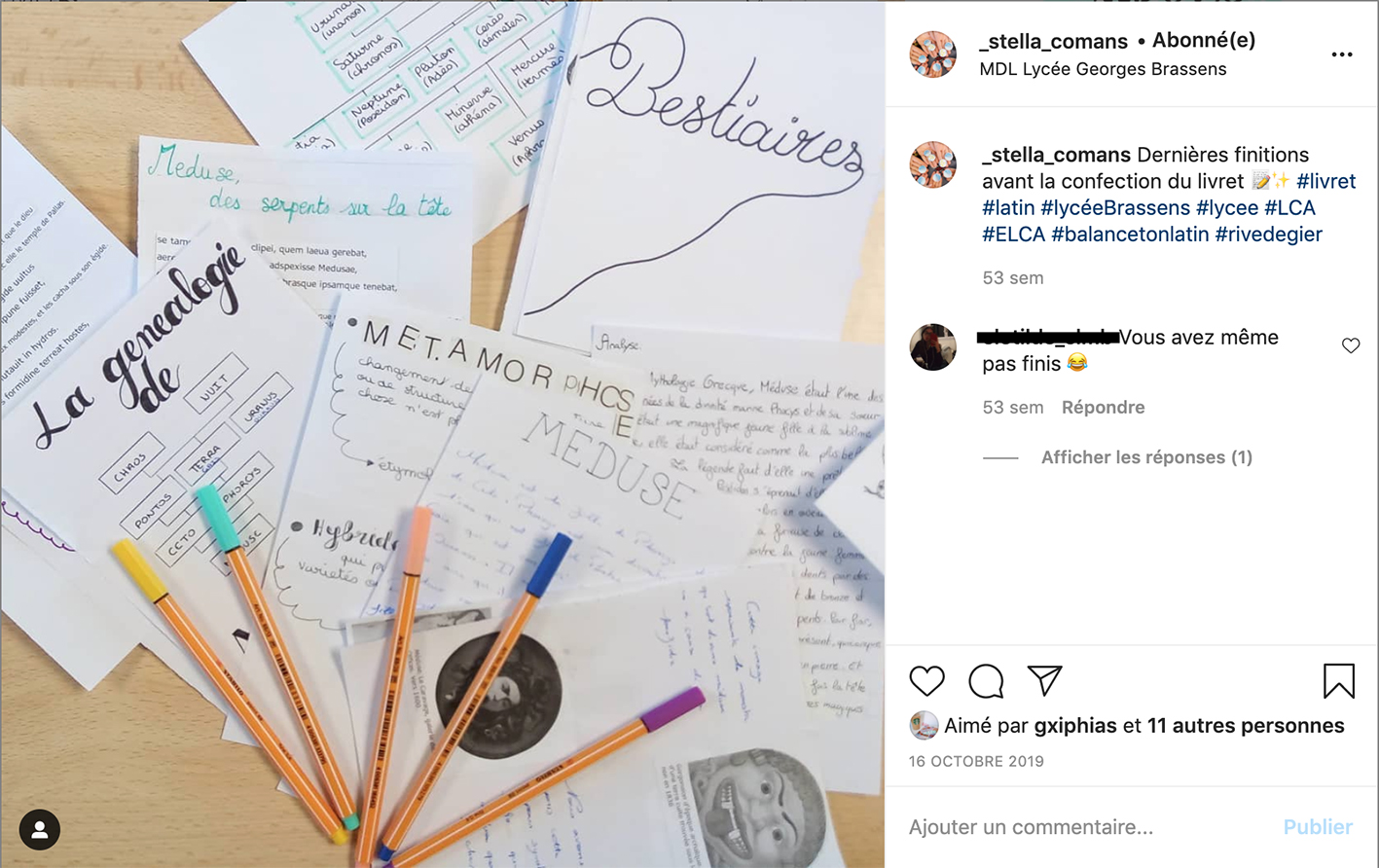
Instagram @_stella_comans
Figure 7. Screenshot of a former Latinist group (2019 project) showing different parts of their future book: "final finishing touches before making the book"
For each of these missions, the teacher remains ready to support the students in their production. For example, they may review the principles of page layout with one group and the organization of a bibliography with another. In this perspective, the students gain skills that do not necessarily relate to Latin but allow them to be the architects of their project.
3.5. Fourth mission: appropriate a quote and take it out of the classroom
Once the book is ready, each group is assigned a quote that they have to tag throughout the high school premises. It is essential that students fully own the quote, so, before using it, the students apply themselves to identifying and translating each term. "In nova fert animus mutatas dicere formas corpora" is one of those quotes.
Before disseminating this quote in the school, the students create a poster that presents the quote and provides a translation (Figure 8).
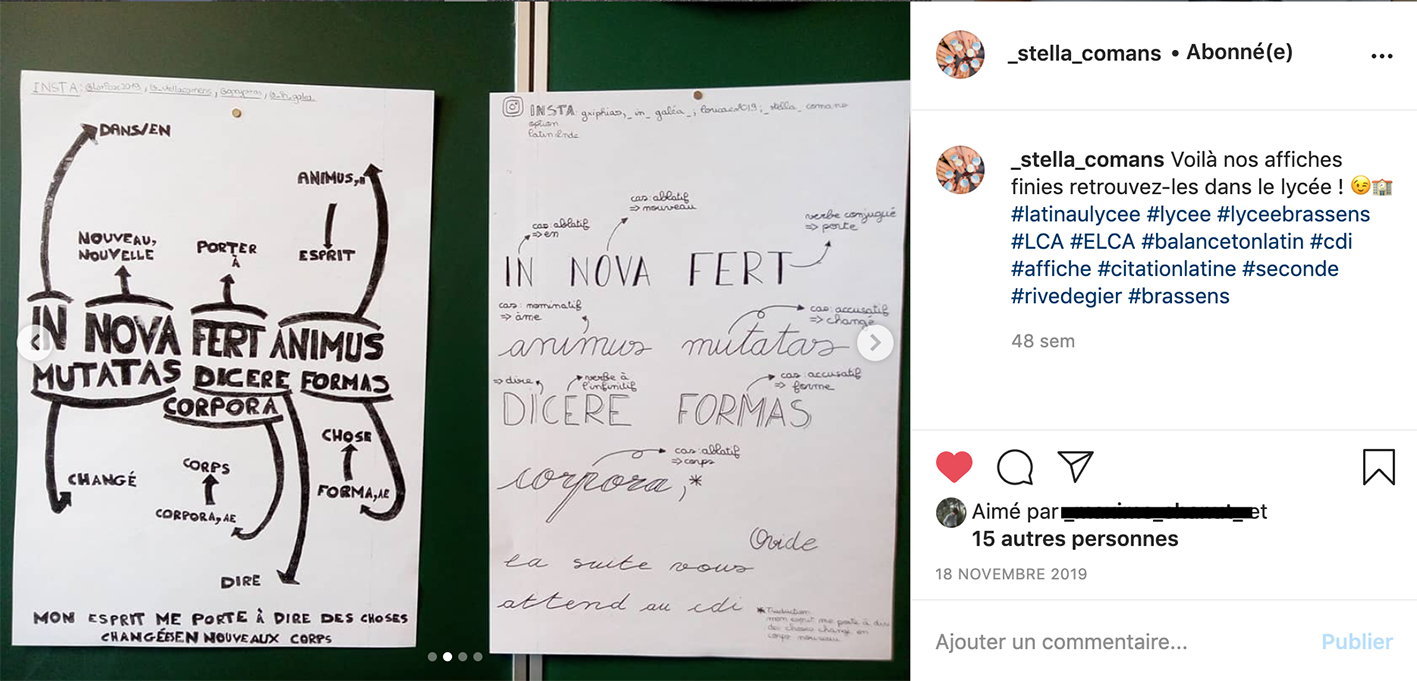
Instagram @_stella_comans
Figure 8. Screenshot of a former Latinist group (2019 project) showing different posters for the quote "in nova fert animus mutatas dicere formas corpora", or "here are our finished posters, find them in the school"
While tagging Latin quotes on the school floor is primarily recreational and creative, it also serves two educational purposes. First, having to repeat and space this quote regularly with a stencilled inscription allows students to thoroughly learn it. There is scientific literature on the act of repetition as a means of memorising. Ebbinghaus (2010) was able to demonstrate that memorising items is more effective when the learning phase involves repetition, on the condition that the repetition of the items, the quotes in this instance, are spaced. Gerbier and Koenig (2015) rightly recall that "depuis les travaux d'Hermann Ebbinghaus à la fin du XIXe siècle, on sait qu'espacer dans le temps les épisodes d'apprentissage influence grandement la rétention ultérieure. C'est l'effet de pratique distribuée"18. However, during the year, the students involved in the project under discussion are required to tag "carpe diem quam minimum credula postero", then "omnes horas complectere" before again tagging again "carpe diem". This requires them to recall the translation of these quotes regularly and, ultimately, to withhold them because eventually it starts making sense.
The second objective is to provide everyone (Latinist and non-Latinist students) with common cultural references. The quotations are in fact, as previously mentioned, selected for their capacity to be retained and reused. "Carpe diem quam minimum credula postero" belongs to a general culture and is sometimes even used in tattoos, but not always understood.
Finally, once the various elements, posters and books have been assembled, the students exhibit their documents in the school library (Figure 9). Once the objects of mediation with the staff and other high school students are ready, they can take the chalk bombs and tag the school (Figure 10).
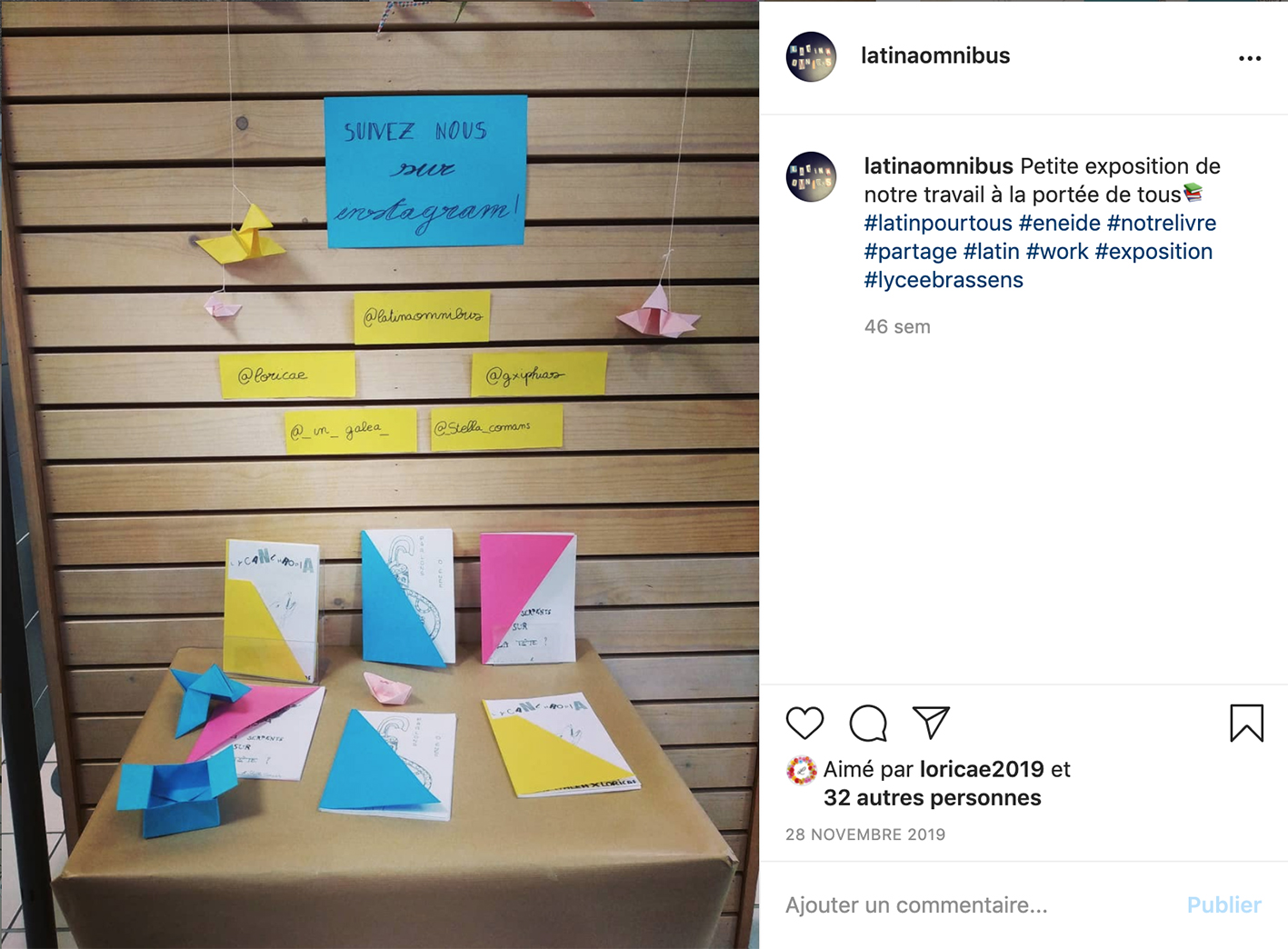
Instagram @latinaomnibus
Figure 9. Screenshot from a former Latinist group (2019 project) showing books in an exhibition in the school library: "Small exhibition of our work accessible to all"
3.6. Self-assessment
In addition to the language assessments, the students must conduct self-assessments linked to their participation in the project, and consider the following questions. Do they think that they have produced what was asked of them? Have they been able to work independently? Have they been active members of the group? Have they been able to create and invent? Do they feel that they had positive attitudes?
These self-assessments are required at the end of the sequence and are combined with an assessment by the teacher, who is able to assess their investment and work throughout the sequence.
4. Results and prospects
The experiment has only recently started, and it is still growing and deepening, related to observations or the difficulties encountered. However, some lessons have already been learned.
First, this experiment questions the position and the role of the teacher, who has to create the learning conditions and support the students in the development of the class project. To support the student's learning, the teacher should be positioned as a mediator between the student and knowledge and become, as Bart (1999) says, "médiateur entre l'élève et le domaine des savoirs qu'il doit étudier pour qu'il puisse y avoir accès, et, à son tour, les faire évoluer"19. The teacher has to accompany the student to make the learner an active participant in his learning. This is particularly significant in the privileged relationship that the teacher can nurture in the context of teaching the language. The teacher is also in the position of a facilitator in student groups. First, conditions have to be created in a manner that will ensure that the balance of participation of each member is respected. Thereafter, the teacher has to listen to the ideas emanating from the members of the group to guide them in their reflections and choices. Finally, the teacher has to ensure that the work is sufficiently well distributed and correctly organised. This approach is geared to assist the learners to develop the ability to research, invent, cooperate and learn.
The first observation is related to the way in which the students gain autonomy. Initially, the 'seconde' may be shy and, for example, ask for permission to stand up, but they rapidly learn, on their own, how to occupy the classroom space, arrange the tables to enable working in a group, use the space on the whiteboard and take the initiative.
The current 'terminale' project is a good example. They are currently working on a collective project to map the Underworld, based on excerpts from the Aeneid. On this occasion, while I suggested that they divide the tasks, I saw N approaching the whiteboard, saying, "we are going to note who does what because, for myself, if I note nothing…", whereupon N wrote down the tasks assigned to each person. A short while later, N said: "I want to take care of it, but I need help", and his comrades appointed an assistant. I also saw them wondering about the doors that dreams go through, and M asked: "is that the ivory one or the other one with horns?" While the students could have turned to the teacher, his classmate replied: "Look in the text". These observations, therefore, reveal that they had acquired enough autonomy and methodology to find the answers they seek.
Moreover, the students are increasingly taking ownership of the project. For example, when the students learned that posters had been damaged by other high school students, the "premières" discussed the problem on their own and proposed solutions, such as to either place the posters only in inaccessible spaces or to provide digital versions, in particular on the school's website. While the majority of the students adhere to the project, it seems that some are still confused by the working method. This could be either because they seem to need a more academic setting, or because they are too shy to fully participate in the group effort. However, no student should be left behind. An evaluation of the experiment by the students will make it possible to understand what some of them may stumble on.
It is difficult to measure progress in language. However, the 'seconde' students of the first year of experimentation, this year in 'terminale', seem to have at least acquired the method of analysing Latin text. They find it more difficult to provide a translation on their own. It is for this reason that I wanted to offer the language-learning program independently this year.
This program is in its first year of experimentation. While it is a bit too soon to be able to look back, I have already made some observations. First, the 'premieres' and 'terminals', who were not used to this way of learning, adapted rapidly and know how to free up time in their schedule for revision. The 'seconde', on the other hand, seem more timid at the moment. Moreover, it seems that the prospect of being allowed a second attempt with the confidence that one will learn from one's mistakes provides a more relaxed environment for learning.
In conclusion, I think I can say that this experiment could be the reason for an increase in the number of students. From five students in 'seconde' the first year, the number increased to 21 the following year and to 26 this year. However, not all the students continue in the following years, and this increase could also be as a consequence of the work of colleagues from 'Collège'20, whom I had asked to promote Latin with their students. However, this experimentation must continue and a means of evaluation must be developed over time. What is certain is that the project appeals, arouses the curiosity of non-Latinists and is an opportunity to bring the language to life by displaying it in the shared space of the school.














